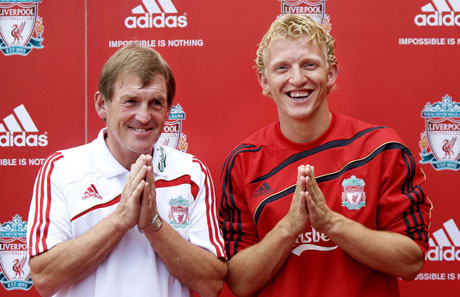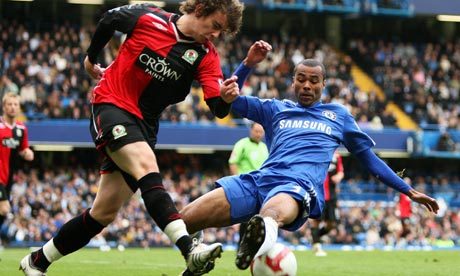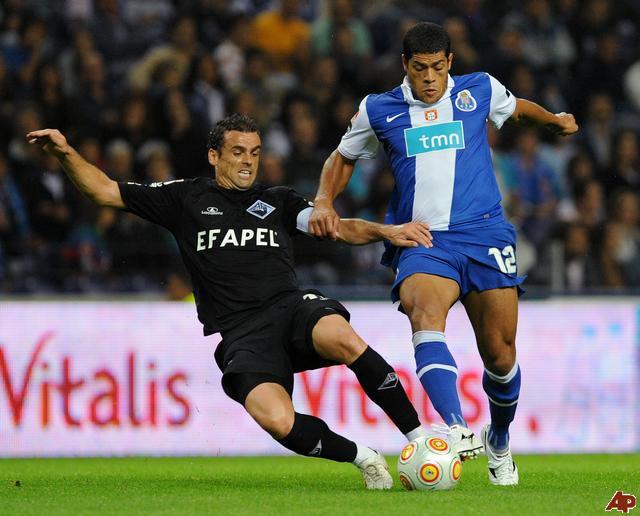-
Recent Articles
Understanding the 4-4-2 Diamond
DEFENCE Despite the fact that there are four ways to play a diamond formation on FM, the differences between them are few and usually subtle. As a starting point, one thing each of them do have...3 at the back and the 4-4-2 Diamond
 Last week Chelsea v Liverpool became the biggest tactical talking point of the season. Liverpool revived the the 3 man defence that Kenny debuted against Stoke. While with the introduction of Torres for £50m...
Last week Chelsea v Liverpool became the biggest tactical talking point of the season. Liverpool revived the the 3 man defence that Kenny debuted against Stoke. While with the introduction of Torres for £50m...How To Set Up A Back Four
 Last year, I wrote a guide about how to play a simple 4-4-2. One of the major components of that is the back four. In fact, most modern formations build upon four defenders; two full backs and two centre...
Last year, I wrote a guide about how to play a simple 4-4-2. One of the major components of that is the back four. In fact, most modern formations build upon four defenders; two full backs and two centre...Building Your Defence: Full Backs
 The modern full back is quickly becoming one of the most important players on the team sheet, infact even back in the days of Brian Clough, fat ed' argued that because of the space these players get in the final...
The modern full back is quickly becoming one of the most important players on the team sheet, infact even back in the days of Brian Clough, fat ed' argued that because of the space these players get in the final...False Nine Tactics
 When we think about modern football trends, we think about the fall of the 4-4-2, the introduction of inverted wingers and the rise of the 4-5-1. But there is one other tactical rise that seems to have...
When we think about modern football trends, we think about the fall of the 4-4-2, the introduction of inverted wingers and the rise of the 4-5-1. But there is one other tactical rise that seems to have...
JOIN 15,808 READERS - SUBSCRIBE NOW TO OUR FOOTBALL MANAGER NEWSLETTER
Get the latest FM news & best community content delivered directly to your e-mail inbox!
Tactical Theorems & Frameworks ’09: Managerial Types & Mentality Systems
Written by: Richard Claydon
Category: Strategy
Posted on: November 23, 2008
November 23, 2008
Managerial Type & Mentality Systems
The two primary tactical instructions (mentality and creative freedom) are the most difficult to translate into real world footballing language. It is difficult to imagine a manager specifying exactly how attacking each player should be or how much he is allowed to deviate from managerial instructions to the degree the sliders allow. Such levels of precision have traditionally caused much angst and argument among FM managers and have often been heavily criticised as being too complex. In attempting to unravel these complexities, we’d like to offer a new conceptualisation of these sliders as determining manager type as much as the tactics of the team.
The two polarities of managerial type are the Authoritarian and the Libertarian manager. The Authoritarian determines every aspect of the team’s play and expects each player to follow his instructions to the letter. Mentality structure will be individually tailored to the players and creative freedom will be close to non-existent. The team will play very precise, controlled football with little flair or creativity and heavily rely on set pieces and set moves to score. On the other hand, the Libertarian manager has a rough idea of how attacking or defensive his team should be for each match and gives players their heads. The mentality structure will be very generic and creative freedom will be high. The team will play free-flowing football and goals will come from all types of open-play moves.
As in real life, these two managerial stereotypes, although potentially successful short-term, are likely to fail in the long run as they are too one-dimensional in approach. The overly structured manager can take his highly controlled style of football to the top level but is often too regimented to remain there, with his teams failing to offer enough flair and creativity to break down high-class defences. However, he should be able to keep a poor squad up simply by playing percentage football. The flair and creativity focused manager will do very well with a squad full of players who can operate at the higher end of the divisional level but will fail to bring enough tactical acumen to the table to win really big matches and titles. With a poor squad, he is likely to be an unmitigated disaster, as he will ask his players to do things of which they are not capable.
As with real life managers, the successful FM09 manager will need to learn how to balance a systematic approach to formation structure with a trust in which players can be allowed the creative freedom to express themselves without disrupting his overall tactical vision. Knowing which type of manager you are will then enable you to choose or design a mentality system that best suits your style. Some systems better suit a manager at the Authoritarian end of the scale, as they can do well with restricted creative freedom, whereas others are friendlier to the Libertarian axis, requiring a lot of creativity and flair to flourish.
No matter which one you choose it is likely that they will need to be tweaked further to suit your own playing preference, managerial style and the ability of the individual players at your disposal. You might be an aggressive manager that tries to impose his particular style of play on the opposition and thus veer towards an attacking framework with low creative freedom. You might examine your opponent’s strategy in fine detail and assign the majority of players to counter it whilst relying on an elite few to do the creative stuff. There is no ‘best way’ to play or manage. However, somewhere there will be a style of play that best suits your temperament and vision. The following section outlines a number of mentality approaches that have worked over the last few versions, alongside their relative suitability to managerial type.
The mentality systems will be presented in order, ranging from the most Authoritarian approaches at the top to the most Libertarian at the bottom. Authoritarian mentality systems assign specified mentalities and instructions to every player, whereas Libertarian ones are more simple and team-based. The mentality structures illustrated indicate how a standard match strategy would look. However, the actual player mentality values shown are just to illustrate the settings and don’t have to be followed precisely. If you are a cautious manager, your starting mentality (DCs) can drop to five. If you are more aggressive, you could have a lowest starting mentality of eleven. To design a complementary attacking strategy, simply raise each value by four to eight notches, depending on your standard settings. For a defensive strategy, lower by four to eight.
NB: We recommend a maximum of eight notches between the most attacking and defensive outfield players for all mentality systems. Greater mentality gaps risk isolating the defence from the midfield and the midfield from the attack.
The Nike Defence
Manager Type: José Mourinho
Although this mentality structure is basically an adaption of the Rule of One (see page 14), it is ideally suited to those that wish to play the Mourinho way. It is exceedingly control-orientated and specifies more individual mentality settings than any other system. It closely mirrors Mourinho’s tactics in two ways. Firstly, it employs an athletic covering DC to support a powerful destroyer in the manner of the Carvalho/Terry Chelsea partnership. Secondly, the MCd sits slightly deeper than he would in the Rule of One, which equates to how Mourinho employed Makélélé. Like all Rule of One tactics, it suits the Mourinho-type manager as it can do well without excessive creative freedom.
GK: 7
DCd: 6
DC: 8
FB: 10
MCd: 9
ML/R: 11
MCa: 12
FCs: 13
Credit: Justified
The Libero Defence
Manager Type: Fabio Capello
As with the Nike Defence, the Libero Defence is a reworking of the Rule of One. Like Mourinho, Capello is very specific about how he wishes each of his players to perform and always employs a deep holding midfielder. However, unlike Mourinho he encourages one of his DCs to advance forward with the ball in the manner of a classic Libero, as seen by Rio Ferdinand’s performances under Capello for England. Allowing a deeper defensive line than the Nike Defence, the Libero Defence better suits the type of controlled, possession football Capello prefers in contrast to Mourinho’s direct, muscular approach.
GK: 8
DC: 8
DCa: 13
FB: 9
MCd: 8
MR/L: 11
MCa: 13
FCs: 14
Credit: Jaswarbrick
Rule of One (RoO)
Manager Type: Martin O’Neill
The Rule of One plays roughly in the same manner as a Martin O’Neill tactic. Like Mourinho and Capello, O’Neill is very fastidious about tactics and expects each of his players to fulfil a specific function. However, he has had much less chance to work with genuinely world-class players, which has led to him employing a more generic system into which players of lesser quality are able to operate. In applying detailed specific mentality and player instructions, O’Neill can overachieve without the need for highly creative or flair players in his attacking line. Relying on detailed tactical structure enables him to employ lowish levels of creative freedom without a drop in performance.
GK: 7
DC: 8
FB: 9
MCd: 10
ML/R: 11
MCa: 12
FCs: 13
Credit: wwfan
Bands of Two
Manager Type: Alex Ferguson
Sir Alex is the first manager that deviates from a very tight control methodology. Manchester Utd’s system, most especially in the Queiroz years, operates through four bands of play. While the central defenders are predominantly instructed to defend (unlike when playing for Capello, Ferdinand stays back) the full backs and defensive midfielder offer deep support for the front line alongside their defensive duties. The attacking midfielder and wingers have become virtually interchangeable, switching roles in the high support band, and are usually allowed their creative heads. The final band is the spearhead forward, ideally a complete player who is comfortable playing with the ball at his feet or in the air.
GK: 8
DC: 8
FB: 10
MCd: 10
ML/R: 12
MCa: 12
FCs: 14
Credit: wwfan & Millie
Role Theory
Manager Type: Arsene Wenger
Moving towards the more expressive mentality systems, in which control structure meets individual responsibility, we find Arsene Wenger. Unlike the other systems, here the mentality matches the player role within the team’s overall match strategy and thus changes depending on how many players are assigned to specific roles (see pages 18-19). When playing an attacking strategy (see page 32), the five attacking roles are on the same mentality, whereas when playing a defensive system (see page 33), five roles are assigned defensive mentalities. The player’s role rather than his individual skills or team system becomes the most important aspect of play. When everything fits into place and all the roles interact perfectly, the football is magical.
Defensive Roles: 8
Supporting Roles: 11
Attacking Roles: 14
Credit: wwfan & Millie
2-6-2 Mentality
Manager Type: Marcelo Lippi
Lippi’s teams have traditionally been some of the more expressive in Italian football, partly to do with his charismatic manner generating team spirit, but mainly due to his flexible approach to tactics. The 2-6-2 system allows considerable flexibility in the middle of the park, with six players interlinking as support group for the attack and defence. As with most Italian approaches, this system can frustrate opponents by dominating possession deep on the pitch as the back two interact with the midfield in an eight player passing system prior to instantaneously turning defence into attack as one of the front players is suddenly picked out in space.
GK: 8
DCs: 8
FBs: 11
MCd: 11
ML/R: 11
MCa: 11
FCs: 14
Credit: zagallo
5×5 Theory
Manager Type: Rafa Benitez
Although Benitez doesn’t come immediately to mind as a Libertarian, his structural approach to tactics is a simple one, relying on five players to defend and five to attack. Although he has transformed Liverpool into a team that is very difficult to break down, criticisms remain with regard to his attacking intentions and lack of width. In typical Spanish manner, Benitez wants his front five to play with creativity and flair, unlocking opposing defences via quick-fire passing interchanges. Without players who have the vision and touch to unlock defences in tight areas this translates into many efficient but dour matches. However, with the right players and creative freedom allowances up front, scintillating attacking play will complement resolute defence.
GK: 8
DC: 8
FB: 8
MCd: 8
ML/R: 12
MCa: 12
FCs: 12
Credit: Asmodeus
Global Mentality
Manager Type: Kevin Keegan
Global mentality suits a manager who is willing to give players their heads and relies heavily on motivation techniques to get the best out of them. When the team is playing well, the global system is capable of outstanding football. However, its relative lack of defensive cover and a tendency to be compressed means that, when things are going less well, it can be outflanked on the counter and squeezed out when attacking. To combat that it requires heavy levels of creative freedom and players who can make the best use of it alongside excellent team discipline and determination. For a manager confident of his team-talks and media interaction it can be a great system.
All Players: 11
Effective Strike Partnerships
Although we have specified two types of forward, the mentality frameworks only specify one FC setting, despite the requirement for the FCa to play higher up the pitch than the FCd. The reason for the omission is the difference in instructions for Attacking, Standard and Defensive mentality systems.
In all systems, it is important that there is a reasonably large mentality split between the two forwards. This stops the opposing defence from being able to hold a single line that denies both forwards space. One FC drops deeper to find space in front of the line, whereas the other plays higher to try and move into space beyond it. In a defensive system, the mentality framework directly links to the lower FCd settings, with the FCa being assigned a higher mentality to ensure he is playing on the shoulder of the last defender. In an attacking system, the mentality framework directly links to the higher FCa settings, with the FCd being assigned a lower mentality to ensure he drops deep into space.
Using the suggested mentality setting of the DC as a base (x) we recommend the following settings as a rough guide for an effective strike partnership.
Defensive: FCd (x + 5); FCa (x +
Standard: FCd (x + 3); FCa (x + 7)
Attacking: FCd (x + 1); FCa (x + 6)
However, for a Global Mentality System the formula is slightly different:
Defensive: FCd (x); FCa (x + 4)
Standard: FCd (x - 2); FCa (x + 2)
Attacking: FCd (x - 4); FCa (x)
These settings can be altered depending on the ability and speed of the forwards, the starting mentality of each system and the specific managerial vision.
About The Author: Richard Claydon
Tactical theory has evolved massively down the years, from Diablo-style beat-’em-alls through Cleon’s era to the present day systems inspired by wwfan’s theories. Richard is considered to be the authority on FM tactics, and was approached by Sports Interactive to help write the new tactical interface in Football Manager Live and Football Manager 2010.
Download Our Tactical Theorems '10 eBook Absolutely Free

Presenting the most comprehensive tactic design and match strategy guide to the Football Manager series ever created!
Written by FM match engine beta testers, it's 60+ pages of easy-to-read concepts and ideologies for getting your team playing exactly how you want each match! It's been downloaded over 100,000+ times to date!
Find out more information about our tactical eBook
and download Tactical Theorems '10 right now!
Written by FM match engine beta testers, it's 60+ pages of easy-to-read concepts and ideologies for getting your team playing exactly how you want each match! It's been downloaded over 100,000+ times to date!
and download Tactical Theorems '10 right now!




